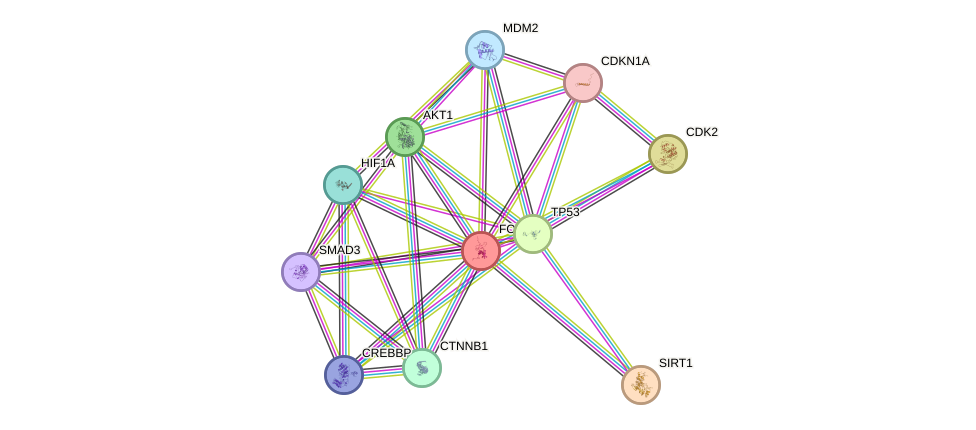GenAge entry for FOXO3 (Homo sapiens)
Gene name (HAGRID: 123)
- HGNC symbol
- FOXO3
- Aliases
- AF6q21; FOXO2; FKHRL1; FOXO3A
- Common name
- forkhead box O3
Potential relevance to the human ageing process
- Main reason for selection
- Entry selected based on evidence linking the gene or its product to human longevity and/or multiple age-related phenotypes
- Description
A transcription factor of the Fox family, FOXO3, is crucial in development [802]. It also appears to regulate apoptotic signals in conjunction with FAS and AKT1.
A homologue of FOXO3, daf-16, has been associated with ageing in roundworms [628], and overexpression of another homologue, dFOXO, in adult fat body of fruit flies increased longevity in females [1238]. Female mice without FOXO3 showed an ovarian phenotype of follicular activation leading to oocyte death, early depletion of functional ovarian follicles, and secondary infertility [625].
Two studies of genetic variation within FOXO3, have found it to be associated with exceptional human longevity, among people of Japanese [1987] and German [1983] origin. The G allele of FOXO3 single nucleotide polymorphism (SNP) rs2802292 has been associated with longevity in multiple populations. G-allele carriers among combined Japanese, white and black populations have a risk reduction of 10% for total mortality [4357].
Cytogenetic information
- Cytogenetic band
- 6q21
- Location
- 108,560,866 bp to 108,684,768 bp
- Orientation
- Plus strand
Protein information
- Gene Ontology
-
Process: GO:0000122; negative regulation of transcription from RNA polymerase II promoter
GO:0001542; ovulation from ovarian follicle
GO:0001544; initiation of primordial ovarian follicle growth
GO:0001547; antral ovarian follicle growth
GO:0001556; oocyte maturation
GO:0006357; regulation of transcription from RNA polymerase II promoter
GO:0006366; transcription from RNA polymerase II promoter
GO:0006417; regulation of translation
GO:0007568; aging
GO:0030330; DNA damage response, signal transduction by p53 class mediator
GO:0031667; response to nutrient levels
GO:0033209; tumor necrosis factor-mediated signaling pathway
GO:0034599; cellular response to oxidative stress
GO:0042493; response to drug
GO:0043065; positive regulation of apoptotic process
GO:0043525; positive regulation of neuron apoptotic process
GO:0045648; positive regulation of erythrocyte differentiation
GO:0045665; negative regulation of neuron differentiation
GO:0045893; positive regulation of transcription, DNA-templated
GO:0045944; positive regulation of transcription from RNA polymerase II promoter
GO:0048854; brain morphogenesis
GO:0071333; cellular response to glucose stimulus
GO:0071386; cellular response to corticosterone stimulus
GO:0071456; cellular response to hypoxia
GO:0071548; response to dexamethasone
GO:0090090; negative regulation of canonical Wnt signaling pathway
GO:0097150; neuronal stem cell population maintenance
GO:0097192; extrinsic apoptotic signaling pathway in absence of ligand
GO:1901300; positive regulation of hydrogen peroxide-mediated programmed cell death
GO:1903428; positive regulation of reactive oxygen species biosynthetic process
GO:1904646; cellular response to beta-amyloid
GO:1990090; cellular response to nerve growth factor stimulus
GO:1990785; response to water-immersion restraint stress
GO:2000177; regulation of neural precursor cell proliferation
GO:2000353; positive regulation of endothelial cell apoptotic process
Cellular component: GO:0005634; nucleus
GO:0005654; nucleoplasm
GO:0005737; cytoplasm
GO:0005739; mitochondrion
GO:0005829; cytosol
GO:0016020; membrane
Hide GO termsFunction: GO:0001047; core promoter binding
GO:0001221; transcription cofactor binding
GO:0001227; transcriptional repressor activity, RNA polymerase II transcription regulatory region sequence-specific binding
GO:0001228; transcriptional activator activity, RNA polymerase II transcription regulatory region sequence-specific binding
GO:0003677; DNA binding
GO:0003700; transcription factor activity, sequence-specific DNA binding
GO:0005515; protein binding
GO:0008013; beta-catenin binding
GO:0019901; protein kinase binding
GO:0031490; chromatin DNA binding
GO:0043565; sequence-specific DNA binding
Protein interactions and network
- Protein-protein interacting partners in GenAge
- TP53, TERT, ATM, AKT1, MYC, BRCA1, CREBBP, EP300, PCNA, RB1, SIRT1, YWHAZ, MDM2, H2AFX, CTNNB1, SIRT3, IKBKB
- STRING interaction network
Retrieve sequences for FOXO3
Homologs in model organisms
In other databases
- GenDR gene manipulations
- A homolog of this gene for Mus musculus is present as Foxo3
- LongevityMap
- This gene is present as FOXO3
- CellAge
- This gene is present as FOXO3

